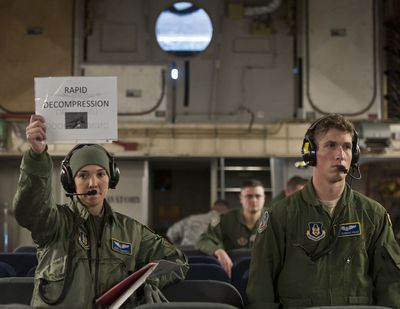In-flight drills test trainees
Base makes most of fewer available training exercises

TACOMA – The Joint Base Lewis-McChord flight nurses in the air over the Northwest on Sunday had unbelievably bad luck during their training scenario inside a C-17 Globemaster III jet.
A series of imaginary in-flight fires, patient heart attacks, fuel leaks and crash landings tested the nurses from the 446th Reserve Airlift Wing’s aeromedical evacuation squadron.
All they needed were snakes in the cockpit, and the absurdly troubled flight might have been fit for Hollywood.
“This is like the (worst) airplane ever,” Capt. Stephen Smith laughed as his mission trainer called out the fake news that their aircraft was leaking fuel somewhere over Oregon.
“Now we’ve got an alternate landing,” he said, using a euphemism for “crash.”
Thankfully, the nurses have never known such a disastrous flight on their real-life missions taking ill, injured and wounded troops from the battlefield to military hospitals around the world.
They crammed the unfortunate events into their monthly training to make the most of limited time in the air. Recent restrictions on military spending mean the Air Force has fewer training flights than it’s had in past years, airmen said.
This time, the wing stretched its training dollars by doubling the number of medical teams in the jet and incorporating work on the ground from a sister unit, called the 446th Aeromedical Staging Squadron.
All told, about 50 airmen on the ground and air squadrons got valuable training time from a single four-hour flight. More than 30 of them were aboard the jet.
Normally, the crews consist of five in-flight medics, a pilot, a co-pilot and a loadmaster who manages the back of McChord’s cargo jets.
“Resources and funds are so limited now that when we fly a four-hour local mission, we’re looking at trying to get the best bang for our buck,” said Senior Master Sgt. J.P. Wirth, a 30-year Air Force veteran who evaluated the airmen on the weekend flight.
Airmen in the wing have deployed continually to the wars in Iraq and Afghanistan over the past 12 years, usually in small groups rather than an entire squadron. Their job is to keep wounded and ill service members stable while moving to care facilities in the war zone and then on their way home to the United States.
The evacuation and staging squadrons have intertwined missions. Airmen in the staging squadron check patients to make sure they’re ready to fly, then escort them onto planes or divert them to further care on the ground. The nurses in the evacuation squadron take over once the patients get on the plane.
But the two groups only recently started training together at Lewis-McChord. At past training events, each squadron would pretend that someone else did the sister unit’s mission.
“We’ve been talking about it for years, and it just clicked,” said Senior Master Sgt. Jonathan Lapham, a member of the staging squadron.
This time, the airmen on the ground got a good look around the jets they’d see on a deployment.
“I’ve never seen a plane this full,” Capt. Ryan Garabrandt said.
The storyline for the weekend exercise simulated a flight from a military hospital in Germany to Joint Base Andrews in Maryland. It’s a common flight representing a leg of the journey for wounded soldiers from Afghanistan on their way to care at Walter Reed National Military Medical Center.
That basic mission quickly devolved when trainers started putting the nurses under stress, evaluating their responses to fictitious disasters.
Airmen had to use their imaginations to work through the drills. They fought fires and stabilized mannequins that represented burned patients only to face more obstacles.
In some cases, tasks were especially difficult because the challenges were not real. Medics had to look at the mannequin, respond to verbal descriptions of the patient’s ailments and then decide how to act.
That slowed the nurses because they could not respond instinctively to a patient’s distress.
“When you’re deployed, you don’t have to think. You see the patient. It’s visible,” said Maj. Shana Weber, 37, who also works as a nurse at Tacoma General Hospital.
One of the trainers was nurse Capt. Noel Carroll. She joined the Air Force in 2009 after her brother, Air Force combat controller Staff Sgt. Timothy Davis, was killed by a bomb in Afghanistan.
On Sunday, she called out one disaster after another to a team of medics. In real life, Carroll, 31, said nurses face many challenges caring for troops, but “you don’t have these emergencies back to back to back.”
She deployed to Afghanistan for the first time in the summer and fall of 2012. Her calling to join the military hit home when she visited a gym at Bagram Air Field named after her fallen brother. She exercised there as much as she could.
She’s ready to go back if she gets the chance. Her assignment caring for wounded troops on the battlefield gave her a feeling that “you are actually making a difference.”